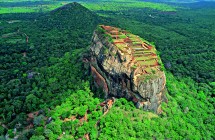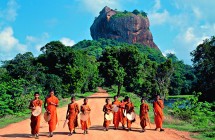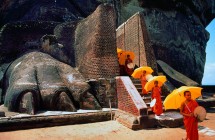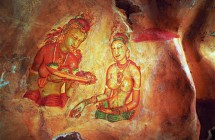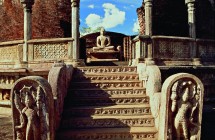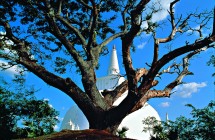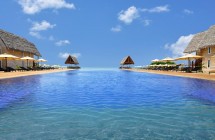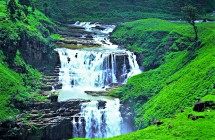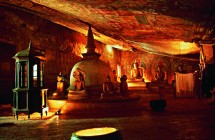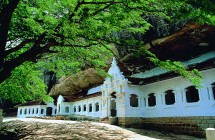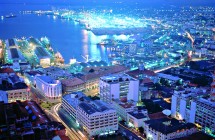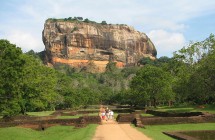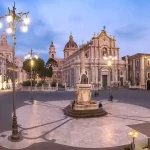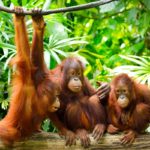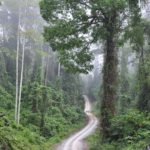A wonder of amazing experiences visiting ancient sites and learn unique culture
Day 1: AIRPORT / HABARANA or DAMBULLA
Arrival at the Colombo International airport. After immigration and customs formalities make your way outside the baggage area . Receive a warm welcome from our uniformed representative. Transfer to Habarana or Dambulla.
Overnight stay at the Hotel.
Day 2: HABARANA or DAMBULLA / POLONNARUWA / SIGIRIYA / HABARANA or DAMBULLA
Breakfast at the hotel & proceed to Polonnaruwa.
Polonnaruwa – is the 2nd capital of Sri Lanka. Built in the 11th and 12th centuries A.D, and is a world heritage site. Here you can see the ruins of the Royal Palace, the Gal Viharaya (3 splendid statues of the Buddha in upright, sedentary and recumbent postures carved out of rock). The audience hall, the lotus bath, the Polonnaruwa statue (12th century) and the Parakrama Sam udra tank (lake) built by king Parakramabahu the great. There are also ruins of famous places of worship such as the Shiva temple, the Lankatileka, the Watadage, the Galpotha, the KiriVihareDagoba and the remains of a former temple of the tooth.
Afterwards proceed to Sigiriya and climb and sightseeing of the UNESCO World Heritage Sigiriya Rock fortress.
Sigiriya sometimes also referred to as the eighth wonder of the world dates back from over 7,000 years ago, through Pre-Historic to Proto-Historic to Early Historic times, then as a rock-shelter mountain monastery from about the 3rd century BC, with caves prepared and donated by devotees to the sangha. The garden city and the palace were built by Kasyapa 477 – 495 AD. Then after Kasyapa’s death it was a monastery complex upto about the 14thcentury. Sigiriya is a unique witness to the civilization of Ceylon during the years of the reign of Kassapa I. The site of the ‘Lion Mountain’ was visited from the 6th century AD, by passionate admirers. The frescoes of Sigiriya inaugurated a pictorial style which endured over many centuries. Halfway up the rock, within an inaccessible rocky shelter in the vertical wall of the western face these rock paintings can be seen which have brought universal acclaim to the site of Sigiriya – ‘The Maidens of the Clouds’, 21 non-identified female figures, comparable to the most beautiful creations of Ajanta. Though traces of plaster and pigments occur all over this area, only two pockets of paintings survive. These are in a depression of the rock face, about 100 meters above the ground level. These paintings represent the earliest surviving examples of a Sri Lanka school of classical realism, already fully evolved by the 5th century, when these paintings had been made. Earlier the Sigiri style had been considered as belonging to the Central Indian school of Ajanta, but later considered as specifically different from the Ajanta paintings. The ladies depicted in the paintings have been variously identified as Apsaras (heavenly maidens), as ladies of Kasyapa’s court and as Lightening Princess and Cloud Damsels. Overnight stay at the Hotel
Day 3: HABARANA or DAMBULLA / ANURADHARPURA / HABARANA or DAMBULLA
After breakfast at the hotel departure to Anuradhapura
Anuradhapura – is located in the north central part of the Island, it was the first capital and undoubtedly the grandest city of ancient Sri Lanka. It is the home of two world heritage sites. Many places of historical and archeological interest could be visited. Sri-Mahabodhi (sacred Bo-tree), brought as a sapling of the tree under which the Buddha attained enlightenment, it is over 2,200 years old and is the oldest historically documented tree in the world. Brazen palace (2nd cent.B.C.) the 1600 stone columns you see are all that is left of a magnificent multi-storied residence for monks. RuwanweliSeya (2nd cent. B.C). this is the most famous of all the Dagobas. It originally depicted the perfect “water-bubble” shape that modern restoration has not been able to accurately reproduce. Samadhi Buddha (3rd cent. B.C.), one of the most famous statues, depicting the Buddha in a state of “Samadhi” or deep meditation. Isurumuniya rock temple (3rd cent. b.c.) Well known for its rock carving of “the lovers”. KuttamPokuna – twin ponds (3rd cent. B. C.) used by the monks of old as a bathing pool. Thuparama Dagoba (3rd cent. B.C.), the oldest Dagoba in the island. It enshrines a relic of the Buddha.
Mihintale – was where Buddhism was first introduced to Sri Lanka and is therefore regarded as the cradle of Buddhism. On this rock are many shrines and dwellings, originally used by monks. A grand stairway of 1,840 steps made of granite slabs 15 feet wide, leads to the summit from where one could get a splendid view of the surrounding countryside. Return to the hotel. Overnight stay at the Hotel
Day 4: HABARANA or DAMBULLA / MATALE / KANDY
After breakfast at the hotel proceed to Kandy. En route visit Dambulla Rock Cave temple.
After breakfast at the hotel proceed to Dambulla Rock Temple – was built by king Walagambahu in the 1st century B.C. Dambulla is a world heritage site andis the most impressive of Sri Lanka’s cave temples. The complex of five caves with over 2000 sq. meters of painted walls and ceilings is the largest area of paintings found in the world. The caves contain over 150 images of the Buddha of which the largest is the colossal figure of the Buddha carved out of rock and spanning 14 meters.
Proceed towards Kandy. En route visit a spice garden to see the different spices that Sri Lanka is famous for. You will be introduced to different spices and shown how some of these spices are grown and processed.
Arrive in Kandy. In Kandy witness a traditional Sri Lankan dance show. Kandyan dance takes its name from Kandy, the last royal capital of Ceylon, which is situated about 72 miles (120 kilometers) from the modern capital at Colombo. This genre is today considered the classical dance of Sri Lanka. In Sanskrit terminology it is considered pure dance (Natta); it features a highly developed system of Tala (rhythm), provided by cymbals called thalampataa. There are five distinct types; the ves, naiyandi, uddekki, pantheru, and vannams. The usual instruments used in the Kandyan dancing was Getaberaya the traditional drum of the hill country & a small cymbal like instrument called as ‘Thalampota’. Regardless of the changes the country & its culture went through Kandyan dancing still leads the arena as the national dance form of Sri Lanka.
Overnight stay at the Hotel.
Day 5: KANDY / PINNAWALA / PERADENIYA / KANDY
After breakfast at the hotel proceed to Pinnawela. Pinnawala Elephant Orphanage – is a home for about 60 elephants (out of which around 50 are baby elephants) found abandoned or orphaned in the wild. They are being cared, fed and trained by the wild life authority. The best time for your visit is at 9 in the morning, when you will have the opportunity of seeing these ‘babes’ being bottle-fed. You could also see the elephants having their daily baths at a river close by.
Return to Kandy.
City tour of Kandy, The Temple of the Tooth, the palatial complex, and the sacred city of Kandy are directly and tangibly associated with the history of the spread of Buddhism, one of humanity’s great religions. Built to house the relic of the tooth of Buddha, which had come from Kalinga (Orissa State, India) to Sri Lanka during the reign of Sri Meghavanna (310-28), when it was transferred a final time, the Temple of Kandy bears witness to an ever flourishing cult.
Kandy, founded in the 14th century, is the southern tip of Sri Lanka’s ‘Cultural Triangle’. The city became the capital of the kingdom in 1592, during a troubled time when many of the islanders were fleeing to the interior, away from the coastal areas the European powers were fighting over. Although taken several times, the city remained one of the bastions of Sinhalese independence until the British troops entered it on 14 February 1815. From Vimala Dharma Suriya I (1591-1604) to Sri Wickrama Rajasinghe (1798-1815), it was the last seat of royal power. It remains the religious capital of Buddhism and a sacred city for millions of believers. Enshrined in the Dalada Maligawa is the relic of the tooth of Buddha which has long been greatly venerated. Return to the hotel. Overnight stay at the Hotel.
Day 6: KANDY / NUWARA ELIYA
After breakfast at hotel proceed to Nuwara Eliya. En route visit a Tea factory in Nuwara Eliya.
Tea Plantation – visit a tea plantation and a tea factory where one the best Tea in the world is produced. You will be told all about the process of manufacturing tea and also see how tea is graded. Taste a cup of pure Ceylon tea in the factory.
Upon arrival in Nuwara Eliya check-in to the hotel
Do a city and sightseeing tour in Nuwara Eliya
Nuwara Eliya- is Sri Lanka’s premier hill resort with a fine bracing mountain climate. Nuwara Eliya is also the heart of Sri Lanka’s tea country producing 50% of the world’s best tea. Sri Lanka’s highest mountain Pidurutalagala (8282 ft) is located here. Nuwara Eliya is the location.
Day 7: NUWARA ELIYA / COLOMBO
After breakfast at hotel proceed to Colombo and city tour.
Colombo – like many capital cities in developing countries Colombo is fast changing its face. Almost overnight, skyscrapers arise from where old buildings once stood, yet in some parts; the old world charm is retained. A 100-year-old c lock tower and several British built, colonial buildings are still to be seen in the city. The Pettah bazaar – where one can shop for bargains, a Hindu and a Buddhist temple, residential areas where you find the stately homes of the affluent, the Colombo museum (outside visit only) , the Bandaranaike memorial international conference hall – an outright gift to Sri Lanka from the people’s republic of china, the new parliament in Sri Jayawardenapura and the folk art center are some of the places of interest that one can visit to.
Check in to the hotel. Overnight stay at the hotel.
Day 8: COLOMBO / AIRPORT
After breakfast at hotel transfer to the airport for onward flight.
– END TOUR –


